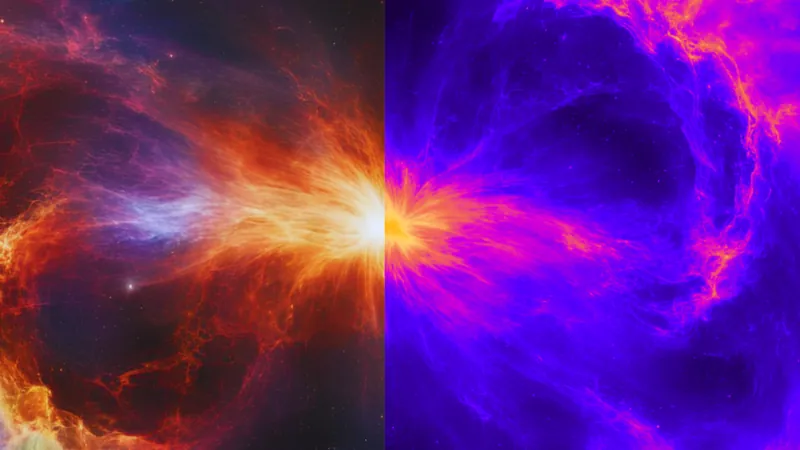
Unveiling Cosmic Secrets: How 'Dark Photons' Could Illuminate the Mystery of Dark Matter
2025-01-08
Author: Ting
Are you ready to unlock the secrets of the universe? Scientists are investigating a revolutionary theory that suggests interactions between dark matter and 'dark photons' during the cosmic dawn, a period shortly after the Big Bang, could illuminate one of the universe's greatest enigmas: dark matter!
Did you know that dark matter makes up about 85% of the universe, compared to the mere 15% accounted for by ordinary matter like stars, planets, and all living things? Despite its dominance in the cosmic landscape, dark matter remains largely invisible because it doesn’t interact with light or photons, which means traditional detection methods fall short. This has stumped researchers for almost a century as they strive to understand what this elusive substance actually is.
But here’s the twist: scientists have hypothesized that dark photons—mysterious particles that may extend the familiar concept of electromagnetism into the realm of dark matter—could actually interact with dark matter in ways we haven’t fully grasped. This revolutionary idea insinuates that dark photons could act similarly to normal photons, interacting with dark matter like light interacts with the everyday matter around us.
A groundbreaking research team posits that these interactions during the first 500 million years after the Big Bang—dubbed the "cosmic dawn"—might have left detectable signatures woven into the fabric of our universe. As Charlotte Mason, an associate professor from the University of Copenhagen's Cosmic Dawn Center, explains, "These interactions could have produced dark acoustic oscillations—ripples that function like sound waves—which stopped just after the Big Bang."
Here’s the real kicker: while dark matter may seem like a mere spectator of the universe, its gravitational influence has been pivotal in shaping the cosmos. It served as a scaffolding for the formation of the first galaxies, indicating that the cosmic dawn is a prime moment to study how dark matter contributes to galaxy formation. Mason states, "Understanding the details of this process at cosmic dawn is critical to piecing together the larger puzzle of the universe’s evolution."
Thanks to advancements in technology, particularly the breakthrough capabilities of the James Webb Space Telescope (JWST) alongside radio telescopes like the Hydrogen Epoch of Reionization Array (HERA) and the Square Kilometer Array (SKA), scientists are now equipped to dive deeper into this mysterious period. They can utilize cosmic dawn as a unique laboratory to search for imprints left by dark photons, promising to unveil crucial insights into dark matter’s properties.
Mason reveals, "The disruptive effects from galaxies weren't as pronounced during the cosmic dawn, enabling a clearer investigation into dark matter interactions." She notes that if these 'dark acoustic oscillations' exist, they could reveal patterns in galaxy formation, leading to higher densities in certain regions, accelerating the birth of galaxies compared to areas with less dark matter influence.
But don’t get too comfortable—detecting these signals is a mammoth challenge. As gravity evolved over time, the subtle indicators of dark acoustic oscillations may have been smoothed out, complicating our ability to study them today. However, Mason and her team are optimistic. They’ve determined that, under specific criteria, current observational capabilities of HERA could potentially discern these cosmic whispers in the near future.
"This is an exhilarating prospect!" Mason exclaims, emphasizing the importance of ongoing radio observations at HERA. The mysteries surrounding dark matter remain one of physics' greatest riddles, and any breakthrough could prove invaluable for our understanding of the universe.
Stay tuned as we venture into the depths of space and time, seeking the ultimate truth about dark matter. Who knows? The revelations waiting just beyond the horizon might redefine everything we know about our cosmos!

 Brasil (PT)
Brasil (PT)
 Canada (EN)
Canada (EN)
 Chile (ES)
Chile (ES)
 Česko (CS)
Česko (CS)
 대한민국 (KO)
대한민국 (KO)
 España (ES)
España (ES)
 France (FR)
France (FR)
 Hong Kong (EN)
Hong Kong (EN)
 Italia (IT)
Italia (IT)
 日本 (JA)
日本 (JA)
 Magyarország (HU)
Magyarország (HU)
 Norge (NO)
Norge (NO)
 Polska (PL)
Polska (PL)
 Schweiz (DE)
Schweiz (DE)
 Singapore (EN)
Singapore (EN)
 Sverige (SV)
Sverige (SV)
 Suomi (FI)
Suomi (FI)
 Türkiye (TR)
Türkiye (TR)
 الإمارات العربية المتحدة (AR)
الإمارات العربية المتحدة (AR)